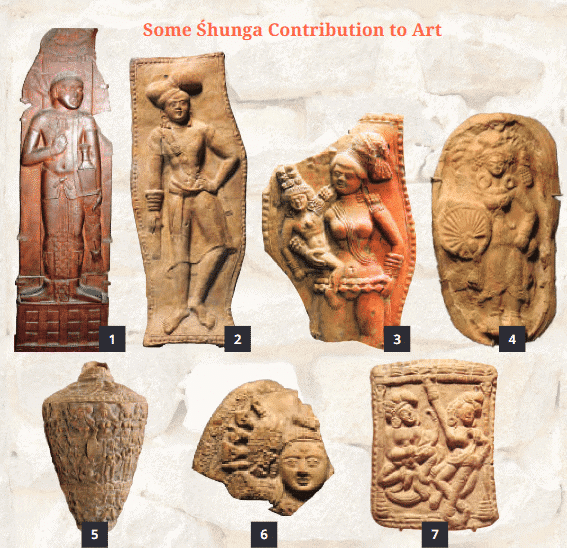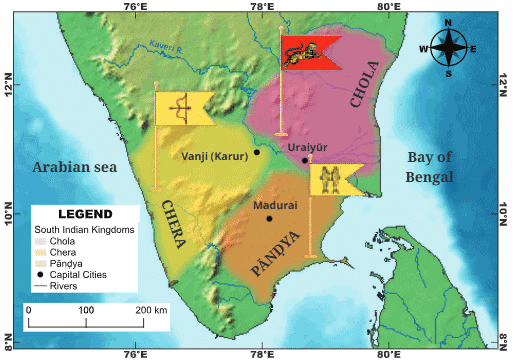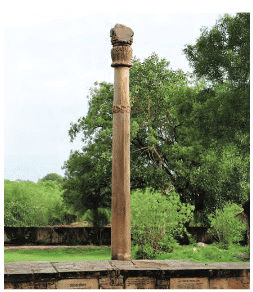Class 7 Social Science Chapter 6 Very Short Answer Questions - The Age of Reorganization
Q1: Who founded the Śhunga dynasty?
Ans: The Śhunga dynasty was founded by Puṣhyamitra Śhunga in 185 BCE.
Q2: What ritual did Puṣhyamitra Śhunga perform to claim unchallenged lands?
Ans: Puṣhyamitra Śhunga performed the ashvamedha yajña, a Vedic ritual involving a horse.
Q3: How long did the Śhunga Empire last?
Ans: The Śhunga Empire lasted for about a century before declining.
Q4: What language became important during the Śhunga period?
Ans: Sanskrit became an important language for philosophy and literature during the Śhunga period.
Q5: Which stūpa was enriched with carvings during the Śhunga period?
Ans: The Bharhut Stūpa was enriched with carvings during the Śhunga period.
Q6: What did the Śhungas contribute to art?
Ans: The Śhungas contributed to carvings depicting stories from Buddha’s life and other cultural elements.
 Shunga Contribution to Art
Shunga Contribution to Art
Q7: Which region did the Sātavāhanas rule?
Ans: The Sātavāhanas ruled the Deccan region, including present-day Andhra Pradesh, Telangana, and Maharashtra.
Q8: What were two key capitals of the Sātavāhanas?
Ans: The Sātavāhanas’ capitals were Amrāvatī and Pratiṣhṭhāna (Paithan).
Q9: What goods did the Sātavāhanas trade with the Roman Empire?
Ans: The Sātavāhanas traded spices, textiles, gold-plated pearls, and ivory with the Roman Empire.
Q10: How did the Sātavāhanas promote trade?
Ans: The Sātavāhanas promoted trade through their strong maritime connections and trade routes.
Q11: What is the significance of the Naneghat Caves in Sātavāhana history?
Ans: The Naneghat Caves were used for collecting tolls and as rest stops for traders.
Q12: What is Sangam literature?
Ans: Sangam literature refers to Tamil poems composed during the Sangam Age, reflecting society and culture.
 Sangam Period
Sangam Period
Q13: Which south Indian kingdoms existed during the Sangam Age?
Ans: The Cheras, Cholas, and Pāṇḍyas were the prominent kingdoms during the Sangam Age.
Q14: Who defeated the Cheras and Pāṇḍyas to become a powerful ruler?
Ans: King Karikāla defeated the Cheras and Pāṇḍyas to become a powerful ruler of the Chola dynasty.
Q15: What was the Kallanai built by Karikāla?
Ans: The Kallanai, or Grand Anicut, was a water diversion system built by Karikāla to irrigate the Kāveri River delta.
Q16: What is the story of Kannagi in the Silappadikāram?
Ans: Kannagi’s story in the Silappadikāram tells of her quest for justice after her husband Kovalan was wrongfully executed by the Pāṇḍya king.
Q17: What was the role of the Cheras in trade?
Ans: The Cheras facilitated trade by exporting spices, timber, ivory, and pearls to the Roman Empire and West Asia.
 Chera, Chola, Pandya
Chera, Chola, Pandya
Q18: What did the Pāṇḍyas trade with the Greeks and Romans?
Ans: The Pāṇḍyas traded pearls and other goods with the Greeks and Romans.
Q19: Who is Khāravela, and what was his significance?
Ans: Khāravela was the ruler of the Chedi dynasty in Kalinga, known for promoting Jainism and his fair governance.
Q20: What is the significance of the Udayagiri-Khandagiri Caves?
Ans: The Udayagiri-Khandagiri Caves, built for Jain monks, feature detailed carvings and spacious rooms.
Q21: What role did the Indo-Greeks play in Indian history?
Ans: The Indo-Greeks ruled parts of northwest India, blending Greek and Indian cultures in art, governance, and daily life.
Q22: What is the Heliodorus pillar?
Ans: The Heliodorus pillar near Vidisha was built by a Greek ambassador and praises Vāsudeva as the "god of gods."
 Heliodorus Pillar Near Vidisha
Heliodorus Pillar Near Vidisha
Q23: Who were the Kuṣhāṇas, and where did they rule?
Ans: The Kuṣhāṇas were Central Asian rulers who controlled northern India and parts of Central Asia.
Q24: What was the significance of Kuṣhāṇa coins?
Ans: Kuṣhāṇa coins depicted kings and deities like Vāsudeva-Kṛiṣhṇa and were used to support trade.
Q25: What is the legacy of Gāndhāra and Mathurā art?
Ans: Gāndhāra and Mathurā art combined Greek and Indian styles, depicting gods and goddesses with realistic figures and detailed robes.
|
23 videos|272 docs|12 tests
|
FAQs on Class 7 Social Science Chapter 6 Very Short Answer Questions - The Age of Reorganization
| 1. What is meant by the "Age of Reorganization"? |  |
| 2. How did the Age of Reorganization impact societies? |  |
| 3. What are some key events that took place during the Age of Reorganization? |  |
| 4. Who were the main figures involved in the Age of Reorganization? |  |
| 5. What were the challenges faced during the Age of Reorganization? |  |





















